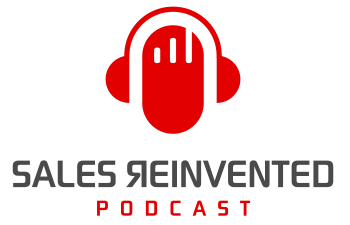
Episode #8 Nick Ostendorf

Meet
Nick Ostendorf
Nick Ostendorf is an ASD Global Sales Trainer with 7 years of experience at 3M. Based in St. Paul, Minnesota, he specializes in the training of sales processes, helping new 3M sales professionals and distributor representatives enhance their understanding of 3M Abrasives. Keeping the customer at the center of every training, Nick emphasizes value-based selling in all his sessions to ensure together we drive positive customer outcomes. He holds a bachelor’s degree in Exercise Science from the University of Wisconsin River Falls. Embarrassing Fun Fact: As a new 3Mer going through the ASD training as an inside sales rep, Nick embarrassingly put a grinding wheel on backwards in front of all his classmates. He has yet to make that mistake twice.
Our Mission Is To Change The Negative Perception Of Sales People
Our Vision Is A World Where Selling Is A Profession To Be Proud Of
Welcome to another episode of the Sales Reinvented podcast, brought to you in partnership with 3M’s Abrasive Systems Division for the Shaped for Success series. In today’s episode, I sit down with Nick Ostendorf, Global Sales Trainer at 3M, to discuss the art and science of objection handling in complex sales.
With seven years at 3M under his belt, Nick shares his firsthand insights and best practices for identifying, managing, and overcoming objections before they become roadblocks. From the importance of pre-call research to leveraging internal networks and tools like Salesforce, Nick unpacks how sales professionals can anticipate objections and turn challenges into opportunities. The conversation covers everything from common objections, like risk aversion, price concerns, and the need for approval, to actionable frameworks for handling objections, such as “stop, collaborate, and listen.”
Outline of This Episode
- [0:00] How to conduct effective discovery to anticipate potential issues.
- [05:43] Involve key stakeholders early in complex sales to avoid delays and objections.
- [07:29] Price objections often arise from not understanding customer needs.
- [10:48] Gain customer commitment before addressing their concession request to ensure clarity moving forward.
- [16:00] A healthy sales pipeline empowers reps to walk away from deals.
- [18:35] Pay attention to the prospect’s tone, body language, take notes, and confirm understanding.
- [24:20] Build trust through active listening, empathy, and evidence; don’t interrupt or get defensive.
- [26:38] “Qualify hard to close easy” by prioritizing effective discovery.
Mastering Objection Handling
Objections are a natural part of every sales conversation, especially in complex, high-stakes environments like those faced by 3M’s Abrasive Systems division. While objections can feel daunting, they’re often signals, clues that, when handled skillfully, pave the way to deeper discovery, trust, and ultimately, mutually beneficial deals. Drawing on insights from sales trainers and experts within 3M, this post explores actionable strategies for identifying, unraveling, and overcoming objections, turning potential deal-breakers into deal-makers.
Proactive Preparation
The best objection handling starts before the meeting even begins. According to Nick Ostendorf, Global Sales Trainer at 3M, thorough pre-call research is essential. Successful sales professionals tap a range of resources:
- Internal Tools: Review sales history in CRM systems like Salesforce, connect with colleagues familiar with the account, and analyze past wins and losses to learn what resonated (or didn’t) with similar buyers.
- External Tools: Leverage forums, LinkedIn, and online groups to identify key stakeholders, understand organizational roles and pain points, and stay ahead of potential market trends or upcoming challenges.
Another powerful technique Nick recommends: utilize “upfront agreements.” By clearly stating the meeting’s purpose, desired outcomes, and giving space for the customer’s agenda, salespeople can unearth hidden hesitations right away, often bringing underlying objections to the surface before they become obstacles.
Discovery and Listening
Objections often signal deeper concerns than what’s voiced. That’s why effective discovery and active listening are vital. Nick stresses the value of listening for both spoken and unspoken cues and using follow-up questions to clarify and dig deeper. Questions like “Can you give me an example?” or “Is there anything else causing concern?” help peel back surface-level objections.
In complex sales, it’s also critical to map the decision-making process early on. Many objections arise due to the need for cross-functional approvals or risk aversion among multiple stakeholders. Bringing all decision-makers into the conversation from the start minimizes later surprises and prevents “gatekeepers” from derailing progress.
Empathy and Collaboration
When objections surface, how you respond matters as much as what you say. The 3M team advocates for a process akin to the AIR² approach: Acknowledge, Investigate, Relate, Respond. Nick offers a pithy version – stop, collaborate, and listen. In practice, this means:
- Stop: Stop selling and acknowledge the objection, showing the customer they’ve been heard.
- Collaborate: Investigate the true source of the concern through open-ended, non-defensive questioning.
- Listen: Confirm understanding and empathize, building trust and rapport.
- Move Forward: Only then, propose solutions or commit to next steps—never making promises you can’t deliver.
Equally important is maintaining an “equal business stature,” being willing to walk away if the fit isn’t right. Displaying this confidence invites buyers to lower their defenses and share honestly, making for more productive discussions.
Transforming Objections into Opportunities:
One powerful story from the 3M sales team involved a distributor partner who balked at a perceived price increase, an apparent deal-breaker. Rather than cave to pressure or simply counter with discounts, the team dug deeper, involving additional stakeholders, including the CEO. Through collaborative discovery, they shifted the conversation from unit price to total value – inventory management, rebates, and operational savings, ultimately securing a multi-million dollar deal. The lesson? Objections handled thoughtfully can lead to even bigger wins than initially expected.
As Nick sums up: “Qualify hard to close easy.” Objection handling isn’t about persuasion tricks, it’s about deep discovery, sincere listening, and co-creating value. Invest upfront, slow down to speed up, and you’ll find that many objections aren’t barriers, they’re bridges to genuine business partnerships.
Connect with Nick Ostendorf
Connect With Paul Watts
Audio Production and Show notes by
PODCAST FAST TRACK
https://www.podcastfasttrack.com
Learn More About Nick Ostendorf
Game-Changer Moment: Can you share a moment in your career when handling an objection effectively completely changed the outcome of a deal?
- As an RDL, I was working shelf conversion with a client who was hesitant due to price and our inability to private label. At a standstill, I asked my champion if we could arrange a call with them and their newly appointed CEO to discuss their concerns and discuss what a “win-win” solution would like with the goal being to move forward or politely walk away. We took a few steps back in the process revisiting discovery and learned they were managing inventory for over 30 different SKUs across all their locations and required by some suppliers to hold certain levels of product. Once we were able to monetize the cost of them managing all this, we put together a consolidation program where 3M would stock and manage the inventory on their behalf eliminating their current expense (specific sales volumes required). Important reminder to get ultimate decision makers involved early for a big picture understanding of how we create value beyond the products we sell.
Best Practices for Early Detection: What are your top three strategies for spotting objections early and addressing them before they stall a deal?
- Up Front Agreements: Slow down to speed up and gain commitment to next steps up front. Start conversations sharing your desired outcome with the customer to align on potential next steps assuming the conversation goes as planned. You will find customers bringing up potential roadblocks which are good to know early and can be incorporated in the conversation.
- Fast Forward: If you want a look into the future… go there. A simple question like, “let’s say the demo goes well and we meet all the expectations you need to see, where do we go from there?” Often you will find hidden objections and be able to discuss those with the prospect before getting too far in the process.
- A Great Discovery: The single best way to get ahead of any objection or identify potential objections in the sales process is an effective discovery. Engage the prospect in a conversation and focus your questions on business priorities / pain points, what their decision-making process looks like, how they interpret “value”, and understanding what success looks like for them. In their responses you will get an idea of where potential roadblocks will pop up and can address them early.
Navigating Tough Objections: What’s the most challenging objection you’ve ever faced, and how did you overcome it?
- When the customer has hesitations if the product or solution will realize the same value from the test in full production. Luckly for 3M representatives, the guarantee trial order is a great way to address this objection risk free for the customer and provide us the opportunity to support with training and ensuring all operators are following SOP and running product till end of life.
Essential Objection-Handling Questions: What are three key questions sales reps should ask when investigating an objection to get to the heart of the issue?
- If we could resolve “objection” to your satisfaction, would you feel comfortable moving forward?
- Its important to isolate the objection and this question tests whether the objection is the true reason for not moving forward or if there are any unspoken reservations. Avoid getting another objection on the other side of your last one when possible.
- Can you tell me more about what’s causing that concern?
- Simple open-ended question that encourages the prospect to elaborate beyond the initial objection and signals that you’re genuinely interested in understanding their perspective, not just trying to brush it aside.
- What would need to be different for you to feel comfortable moving forward?
- This question shifts the focus from the problem to a potential solution and prompts the prospect to think about what would alleviate their concerns and what their ideal scenario looks like.
Future Trends in Objection Handling: With the rise of AI, digital selling, and evolving buyer behaviors, how do you see objection handling evolving in the coming years?
- AI tools will help us spot potential objections before they even come up by analyzing CRM data, past conversations, and buyer behavior. Instead of just reacting, we’ll be able to proactively uncover and address concerns with personalized insights, interactive content and proof of concept ROI calculations based on like customers. Even with all that in mind, at the end of the day tech can’t replace genuine human connection. The best approach will be to combine AI insights with good old-fashioned selling skills so we’re not just solving problems but building trust.
Connect with Nick Ostendorf
Nick Ostendorf LinkedIn URL – https://www.linkedin.com/in/nostendorf/
Share This Episode, Choose Your Platform!
